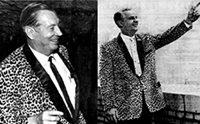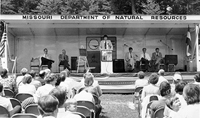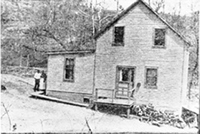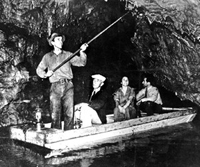at Onondaga Cave State Park
|
|
|---|
1881 - The property was purchased by William H.R. Davis, who built a mill on Davis Spring – now Onondaga Spring – near the Meramec River.
1886 - While examining the spring's outlet on the millpond, Charles Christopher, a local resident who worked at the Davis mill, realized that a cave lay beyond. Later, he and two friends, John Eaton and Mitis Horine, borrowed a small boat and squeezed into the cave for a daylong exploration. Impressed with their discovery, Christopher and Eaton went into partnership and acquired the land above the cave and adjacent to the Davis property. They began development of their "Mammothe Cave of Missouri.”
1897 - Cave mineral deposits, called "cave onyx," were in demand for building stone, and other caves in the area were being mined. The cave was surveyed for mining purposes while tours were given simultaneously.
1902 - Eaton sold his holdings to the Indian Creek Land Co. on May 7, 1902. Disheartened, Christopher sold to the Bothe group, who intended to mine the cave.
Although some test mining was done, the cave's small entrance and a drop in cave onyx prices made mining uneconomical. Cave onyx was too soft and brittle to use for building. Instead, yet another owner, named Eugene Benoist, opened the cave, now known as Davis Cave, as a tourist attraction along the Frisco Railroad.
Circa 1904 - Myrtle Land chose a name for the cave from the names of three American Indian tribes. “Onondaga” is an Iroquois word meaning "people of the mountain." It is unclear exactly when the name was chosen.
1913 - Onondaga was leased to Bob Bradford, who eventually bought the cave, or so he thought. Property disputes with the ancient matriarch of Davis Mill, Artressia Davis, who was convinced she had been bamboozled when Christopher and Eaton bought the land over the cave, continued. Meanwhile, a new dispute between Dr. William Mook and the Indian Creek Land Co. arose.
1930 - Dr. Mook, who had leased a nearby property for a doctor's resort, learned that about half of Onondaga Cave ran under his land. With his brother Robert, Dr. Mook had a tunnel dug into Onondaga Cave, erected a barbed wire fence across the Big Room at the supposed property line, and told Bradford and his tours to stop trespassing.
1932 - Missouri Caverns, Dr. Mook’s portion of the cave, opened as the first electrically lighted cave in the Missouri Ozarks. (Stone ruins from the Missouri Caverns buildings are located to the east of and below State Road H, just up from the current visitor center parking lot.)
With the opening of Missouri Caverns, Bradford had competition – this time from his own cave! Bradford had had success with road signs as automobiles replaced train travel; however, Missouri Caverns was closer to the highway, and Mook's "Cave -- Drive In" sign was intercepting Bradford’s business.
1935 - On May 7, the Missouri Supreme Court ruled in favor of the Mooks and the Indian Creek Land Co. This brought little comfort to Dr. Mook, who had died the previous November.
|
|
|---|
1938 - Bradford had a walkout tunnel from the cave dug. This is the entrance tours still use today. Previously, tourists went in and out by boat through an opening at the spring. After the creation of the new exit, they boated in and walked out.
1939-1944 - Legal problems at Missouri Caverns, along with a decrease in tourism during World War II, caused it to be closed. With the recent death of Bradford, Onondaga Cave's future was shaky.
1945 - Bob Braford’s widow, Mary Bradford, sold out to the Barnard Hospital. Charles Rice, the director of the hospital, gained control of Onondaga Cave, Missouri Caverns and Cathedral Cave. For the first time, Onondaga Cave had one owner. Rural electrification enabled the entire cave to be lighted, and the old generator at Missouri Caverns was replaced. New trails, stairs and bridges were constructed, and Davis Mill was torn down. These improvements were still going on when Rice died in 1949.
 |
|---|
1953 - The Rice estate sold the property to Lester B. Dill and Lyman Riley. Dill had been in the cave business since he was a boy. He had operated both Fisher and Mushroom caves at Meramec State Park and developed Saltpetre Cave into Meramec Caverns. Riley had been a teacher and had worked at both Meramec Caverns and Onondaga Cave. This sale began a time of great popularity for the cave. Riley and Dill made appearances on television game shows; celebrities visited the cave; and there were radio, television, newspaper and magazine advertisements about the cave. Riley became an ordained minister in 1954 and held church services and performed weddings in the cave.
1970s - In 1938, the U.S. Congress approved a dam on the Meramec River near Pacific for flood control. This was initially a plus for Lester and Lyman, who believed that tourism would increase and would improve the local economy. However, in 1943, the U.S. Army Corps of Engineers decided to relocate the dam upstream near Meramec State Park. By the late 1970s, the project was well under way, and controversy erupted among public opinion regarding the resulting lake’s regional impacts.
1973 - Dill joined the Meramec Dam Project opposition after it was discovered that the lake would actually flood up to 80% of Onondaga Cave.
1975 - While the dam controversy raged, Dill briefly reopened Cathedral Cave under the name of its old competitor, Missouri Caverns. New trails and electric lights were installed. Because the cave was opened near the bicentennial year of 1976, the Cathedral Bell, a giant column, was renamed the Liberty Bell. This operation was unsuccessful, and the cave closed again shortly thereafter. Vandals eventually destroyed the lighting system and visitor building.
1978 - Although not binding, a public referendum was held on the Meramec Dam Project, and 64% of the voters opposed. Congress shut down the project.
1981 - With the aid of The Nature Conservancy and the cooperation of the Dill estate, Onondaga Cave became a state park, dedicated to the memory of Dill, who had died a year prior.
1982 - The park was officially dedicated on June 13 and at the same time received a plaque designating it as a National Natural Landmark. Onondaga Cave State Park continues to offer tours of both Onondaga and Cathedral caves, as well as many other forms of recreation.
 |
|---|








